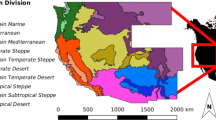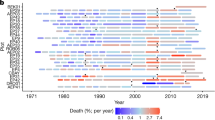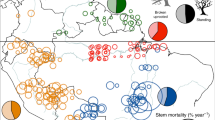Abstract
Lightning is an important agent of mortality for large tropical trees with implications for tree demography and forest carbon budgets. We evaluated interspecific differences in susceptibility to lightning damage using a unique dataset of systematically located lightning strikes in central Panama. We measured differences in mortality among trees damaged by lightning and related those to damage frequency and tree functional traits. Eighteen of 30 focal species had lightning mortality rates that deviated from null expectations. Several species showed little damage and three species had no mortality from lightning, whereas palms were especially likely to die from strikes. Species that were most likely to be struck also showed the highest survival. Interspecific differences in tree tolerance to lightning suggest that lightning-caused mortality shapes compositional dynamics over time and space. Shifts in lightning frequency due to climatic change are likely to alter species composition and carbon cycling in tropical forests.
This is a preview of subscription content, access via your institution
Access options
Access Nature and 54 other Nature Portfolio journals
Get Nature+, our best-value online-access subscription
$29.99 / 30 days
cancel any time
Subscribe to this journal
Receive 12 digital issues and online access to articles
$119.00 per year
only $9.92 per issue
Buy this article
- Purchase on Springer Link
- Instant access to full article PDF
Prices may be subject to local taxes which are calculated during checkout




Similar content being viewed by others
Data availability
The lightning dataset is available in the Dryad repository, https://doi.org/10.5061/dryad.gf1vhhmsp. Data from the Barro Colorado Island 50 ha plot36 are available in the Dryad repository, https://doi.org/10.15146/5xcp-0d46. Data from the lightning risk model7,40 are available in the Dryad repository, https://doi.org/10.5061/dryad.c59zw3r48. Data for wood density37,38 are available in the Dryad repository, https://doi.org/10.5061/dryad.234. Data from the TRY plant database39 are available from the TRY website, https://www.try-db.org/TryWeb/Home.php.
Code availability
The R code used for analysis is available in the Dryad repository, https://doi.org/10.5061/dryad.gf1vhhmsp.
References
Dale, V. H. et al. Climate change and forest disturbances. BioScience 51, 723 (2001).
McDowell, N. et al. Drivers and mechanisms of tree mortality in moist tropical forests. New Phytol. 219, 851–869 (2018).
Esquivel-Muelbert, A. et al. Compositional response of Amazon forests to climate change. Glob. Change Biol. 25, 39–56 (2019).
McDowell, N. G. et al. Pervasive shifts in forest dynamics in a changing world. Science 368, eaaz9463 (2020).
Gora, E. M. & Esquivel-Muelbert, A. Implications of size-dependent tree mortality for tropical forest carbon dynamics. Nat. Plants 7, 384–391 (2021).
Yanoviak, S. P. et al. Lightning is a major cause of large tree mortality in a lowland neotropical forest. New Phytol. 225, 1936–1944 (2020).
Gora, E. M. et al. A mechanistic and empirically supported lightning risk model for forest trees. J. Ecol. 108, 1956–1966 (2020).
Gora, E. M., Burchfield, J. C., Muller‐Landau, H. C., Bitzer, P. M. & Yanoviak, S. P. Pantropical geography of lightning‐caused disturbance and its implications for tropical forests. Glob. Change Biol. 26, 5017–5026 (2020).
Harel, M. & Price, C. Thunderstorm trends over Africa. J. Clim. 33, 2741–2755 (2020).
Maxwell, H. Observations on trees, as conductors of lightning. Mem. Am. Acad. Arts Sci. 2, 143 (1793).
Covert, R. N. Why an oak is often struck by lightning: a method of protecting trees against lightning. Mon. Weather Rev. 52, 492–493 (1924).
Taylor, A. R. Lightning damage to forest trees in Montana. Weatherwise 17, 61–65 (1964).
Furtado, C. X. Lightning injuries to trees. J. Malays. Branch R. Asiat. Soc. 13, 157–162 (1935).
Magnusson, W. E., Lima, A. P. & De Lima, O. Group lightning mortality of trees in a neotropical forest. J. Trop. Ecol. 12, 899–903 (1996).
Yanoviak, S. P., Gora, E. M., Burchfield, J. M., Bitzer, P. M. & Detto, M. Quantification and identification of lightning damage in tropical forests. Ecol. Evol. 7, 5111–5122 (2017).
Makela, J., Karvinen, E., Porjo, N., Makela, A. & Tuomi, T. Attachment of natural lightning flashes to trees: preliminary statistical characteristics. J. Light. Res. 1, 9–21 (2009).
Yanoviak, S. P. in Treetops at Risk (eds Lowman, M. et al.) 147–153 (Springer, 2013).
Gora, E. M., Bitzer, P. M., Burchfield, J. C., Schnitzer, S. A. & Yanoviak, S. P. Effects of lightning on trees: a predictive model based on in situ electrical resistivity. Ecol. Evol. 7, 8523–8534 (2017).
Orville, R. E. Photograph of a close lightning flash. Science 162, 666–667 (1968).
Gora, E. M. & Yanoviak, S. P. Electrical properties of temperate forest trees: a review and quantitative comparison with vines. Can. J. For. Res. 45, 236–245 (2015).
Hietz, P., Rosner, S., Hietz-Seifert, U. & Wright, S. J. Wood traits related to size and life history of trees in a Panamanian rainforest. New Phytol. 213, 170–180 (2017).
Clarke, P. J. et al. Resprouting as a key functional trait: how buds, protection and resources drive persistence after fire. New Phytol. 197, 19–35 (2013).
Kozlowski, T. T. & Pallardy, S. G. Physiology of Woody Plants (Academic Press, 1997).
Bruijning, M. et al. Surviving in a cosexual world: a cost–benefit analysis of dioecy in tropical trees. Am. Nat. 189, 297–314 (2017).
Visser, M. D. et al. Strict mast fruiting for a tropical dipterocarp tree: a demographic cost–benefit analysis of delayed reproduction and seed predation. J. Ecol. 99, 1033–1044 (2011).
Charles, A. E. Coconut lightning strike. Papua New Guin. Agric. J. 12, 192–195 (1960).
Sharples, A. Lightning storms and their significance in relation to diseases of Cocos nucifera and Hevea brasilensis. Ann. Appl. Biol. 20, 1–22 (1933).
Wright, S. J. et al. Functional traits and the growth–mortality trade‐off in tropical trees. Ecology 91, 3664–3674 (2010).
Camac, J. S. et al. Partitioning mortality into growth-dependent and growth-independent hazards across 203 tropical tree species. Proc. Natl Acad. Sci. USA 115, 12459–12464 (2018).
Poorter, L. Leaf traits show different relationships with shade tolerance in moist versus dry tropical forests. New Phytol. 181, 890–900 (2009).
Gora, E. M., Bitzer, P. M., Burchfield, J. C., Gutiérrez, C. & Yanoviak, S. P. The contributions of lightning to biomass turnover, gap formation, and plant mortality in a tropical forest. Ecology 102, e03541 (2021).
R Core Team. R: A Language and Environment for Statistical Computing (R Foundation for Statistical Computing, 2021).
Wickham, H. ggplot2: Elegant Graphics for Data Analysis (Springer-Verlag, 2016).
Brooks, M. E. et al. glmmTMB: Generalized linear mixed models using template model builder. R package version 1.1.3 (2019).
Zeileis, A. & Hothorn, T. Diagnostic checking in regression relationships. R News 2, 7–10 (2002).
Condit, R. et al. Complete data from the Barro Colorado 50-ha plot: 423617 trees, 35 years, 2019 version. Dryad https://doi.org/10.15146/5xcp-0d46 (2019).
Chave, J. et al. Towards a worldwide wood economics spectrum. Ecol. Lett. 12, 351–366 (2009).
Zanne, A. E. et al. Data from: Towards a worldwide wood economics spectrum. Dryad https://doi.org/10.5061/dryad.234 (2009).
Kattge, J. et al. TRY plant trait database—enhanced coverage and open access. Glob. Change Biol. 26, 70 (2020).
Gora, E. M. et al. Data from: A mechanistic and empirically-supported lightning risk model for forest trees. Dryad https://doi.org/10.5061/dryad.c59zw3r48 (2020).
Acknowledgements
B. Adams, M. Detto, R. Ethington, N. Gripshover, R. Kneale and A. Stark assisted in the field. O. Acevedo, M. Cano and the staff of the Smithsonian Tropical Research Institute provided logistical support. This work was supported by grants from the National Science Foundation (DEB-1354060 and DEB-1655346 to S.P.Y., DEB-1354510 and DEB-1655554 to P.M.B., GRF-2015188266 to E.M.G. and DBI-2010942 to J.H.R.) and the National Geographic Society (9703-15 to E.M.G.).
Author information
Authors and Affiliations
Contributions
J.H.R. analysed the data and led the writing of the manuscript. E.M.G. contributed to analyses and collected data. C.G. collected data and managed field operations. J.C.B. and P.M.B. helped design the study. S.P.Y. helped design the study and coordinated the lightning data collection. All authors contributed to writing the manuscript and gave final approval for publication.
Corresponding author
Ethics declarations
Competing interests
The authors declare no competing interests.
Peer review
Peer review information
Nature Plants thanks Kristina Anderson-Teixeira, Kenneth Feeley and the other, anonymous, reviewer(s) for their contribution to the peer review of this work.
Additional information
Publisher’s note Springer Nature remains neutral with regard to jurisdictional claims in published maps and institutional affiliations.
Extended data
Extended Data Fig. 1 Actual vs. predicted probabilities for the lightning mortality model.
Means with 95% confidence intervals (n = 2287) for (a) log-transformed DBH and (b) distance from the struck tree.
Extended Data Fig. 2 Model residuals by species for the lightning mortality model.
Mean residuals for common species (represented by n ≥ 8 individuals in the dataset) with bootstrapped 95% confidence intervals from the mortality model compared to model predictions. Significant differences from zero based on bootstrapping 1000 times: A. standleyanum (p = 0, n = 9), O. mapora (p = 0, n = 9), S. exorrhiza (p = 0, n = 21), F. occidentalis (p = 0.035, n = 79), H. triandra (p = 0.017, n = 28), P. reticulata (p = 0, n = 8), H. crepitans (p = 0, n = 12), G. superba (p = 0, n = 37), D. oleifera (p = 0, n = 13).
Extended Data Fig. 3 Relationship between the average percent crown dieback observed for each species and the mortality model residuals.
Positive residuals indicate that a species died from lightning more often than predicted by the model. Linear regression was weighted by the sample size for each species and is shown with standard error of the mean (R2 = 0.64, F1,29 = 51.31, p = 7.0 × 10−8). Removing palms from the analysis weakened the relationship only slightly (R2 = 0.42, F1,26 = 18.59, p = 0.0002). ALSEBL = Alseis blackiana, APEIME = Apeiba membranacea, AST1ST = Astrocaryum standleyanum, BEILPE = Beilschmiedia tovarensis, CORDBI = Cordia bicolor, DIPTPA = Dipteryx oleifera, FARAOC = Faramea occidentalis, GAR2IN = Garcinia recondita, GUSTSU = Gustavia superba, HIRTTR = Hirtella triandra, HURACR = Hura crepitans, JAC1CO = Jacaranda copaia, LUEHSE = Luehea seemannii, OCOTWH = Ocotea whitei, OENOMA = Oenocarpus mapora, POUTRE = Pouteria reticulata, PRI2CO = Prioria copaifera, QUARAS = Quararibea asterolepis, SIMAAM = Simarouba amara, SOCREX = Socratea exorrhiza, TAB1RO = Tabebuia rosea, TAB2AR = Tabernaemontana arborea, TACHVE = Tachigali panamensis, TET2PA = Protium stevensonii, TRI2TU = Trichilia tuberculata, VIROSU = Virola nobilis.
Extended Data Fig. 4 Recovery and decline of individual trees by species.
Rate of change (ROC) of individual trees between first and last census grouped by species.
Extended Data Fig. 5 Model residuals by species for the resprout model.
Species mean residuals (for species with n ≥ 7 individuals in the dataset) with bootstrapped 95% confidence intervals from the resprout model compared to model predictions. Significant difference from zero based on bootstrapping 1000 times: V. nobilis (p = 0, n = 7).
Extended Data Fig. 6 Relationship between lightning tolerance and lightning damage frequency.
Fig. 3 from main text showing species names for: (a) Mortality model residuals (species with n ≥ 8 individuals) compared with mean damage frequencies projected by the lightning risk model7 by species. The linear regression was weighted by the mortality sample size for each species. Shading indicates the standard error of the mean (R2 = 0.19, F1,24 = 5.78, p = 0.02). When palms (SOCREX, OENOMA, and AST1ST) are removed, this relationship disappears (R2 = 0.10, F1,21 = 2.28, p = 0.15). (b) Residuals from damage and mortality models (for species with n ≥ 8 individuals in the dataset) with DBH removed from both models to capture the full species effect including size differences. The linear regression was weighted by sample size. Shading represents the standard error of the mean (R2 = 0.27, F1,24 = 7.11, p = 0.01). This relationship also disappears when palms are removed (R2 = 0.09, F1,18 = 1.76, p = 0.20). See Extended Data Fig. 2 caption for species codes.
Supplementary information
Supplementary Information
Supplementary Tables 1–4, and Table 5 and Fig. 1 for reanalysis excluding palms, and Tables 6 and 7 and Fig. 2 for reanalysis using only sites located with the camera monitoring system.
Rights and permissions
Springer Nature or its licensor holds exclusive rights to this article under a publishing agreement with the author(s) or other rightsholder(s); author self-archiving of the accepted manuscript version of this article is solely governed by the terms of such publishing agreement and applicable law.
About this article
Cite this article
Richards, J.H., Gora, E.M., Gutierrez, C. et al. Tropical tree species differ in damage and mortality from lightning. Nat. Plants 8, 1007–1013 (2022). https://doi.org/10.1038/s41477-022-01230-x
Received:
Accepted:
Published:
Issue Date:
DOI: https://doi.org/10.1038/s41477-022-01230-x
This article is cited by
-
Old reserves and ancient buds fuel regrowth of coast redwood after catastrophic fire
Nature Plants (2023)
-
Changing forests under climate change
Nature Plants (2022)



